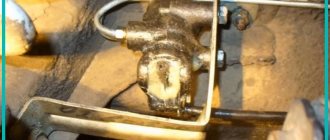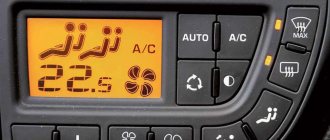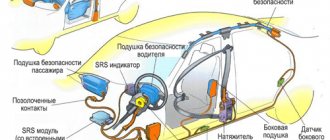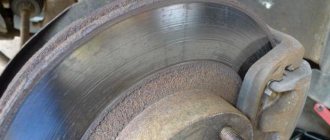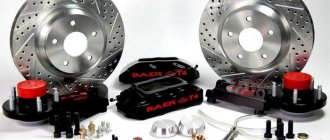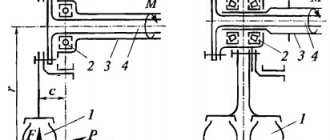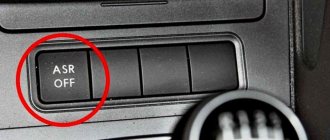19.05.2017
Brake force distribution is a specially designed program of action that helps distribute the load on the wheels when braking on slippery or uneven surfaces. This reduces stopping distances and makes stopping safer and more efficient. Unlike ABS, which only works during hard braking, EBD helps maintain balance throughout the ride. But at the same time, EBD is not an alternative to ABS, but becomes its more effective addition.
What is a brake force distribution system?
The electronic brake force distribution system, most often referred to as EBD (Electronic Brake Distribution), works in tandem with ABS and is a software addition rather than a physical mechanism. Depending on the load on the car, the software distributes the braking force to the wheels, thereby ensuring vehicle stability and controllability.
Typically, in the event of hard braking, the entire force of the load (center of gravity) on the vehicle is transferred to the front, thereby weakening the rear axle. By reducing the load on the rear wheel (regardless of the drive type), there is a huge chance that they can completely lock up. As a result, if the road grip is poor, the car may drift to the side and the rear end may become uncontrollable. It was precisely in order to avoid a similar situation in new cars that, in parallel with ABS, they began to introduce the EBD mechanism.
Advantages and disadvantages
The main advantage is that the electronic brake force distributor allows you to most effectively realize the vehicle's braking potential depending on external factors (load, cornering, etc.). In this case, the system works automatically, and to start it, just press the brake pedal. The EBD system also allows you to brake during long turns without the risk of skidding. The main disadvantage is that, in the case of studded winter tires, when braking using the EBD brake force distribution system, the braking distance increases compared to conventional braking. This disadvantage is also typical for classic anti-lock braking systems. In fact, the electronic brake force distribution system (EBD) is an excellent complement to ABS, making it more advanced. It comes into operation before the anti-lock braking system starts, preparing the car for more comfortable and efficient braking.
Principle of operation
Working principle of EBD
The EBD constantly monitors the rotation of the car's wheels; at the moment of emergency braking, the EBD first comes into play. By reading the speed sensors, the system distributes the braking force so that on each wheel it is appropriate to the conditions in which that wheel is located.
That is, if, for example, during heavy braking, the pressure on the rear wheels is less, then the braking force on the front wheels should be reduced to maintain balance.
When braking in a corner, the procedure changes slightly, because there is a difference in load not between the front and rear axles, but between the left and right wheels. However, the basic principle of the EBD brake force distribution system remains - to create the right balance between all wheels for maximum effective braking.
Operating principle of the EBD brake force distribution system, video
Trigger limits
Naturally, no system can operate in conditions exceeding the capabilities of any electronics. So, if the grip of the wheels with the surface is too uneven, slippery ice and asphalt - for example, any electronic assistants can fail.
The braking force on wheels on asphalt will decrease to balance with wheels on ice, and this is almost like releasing the brake pedal completely. In such borderline situations, the nuances will depend on the settings of all active safety systems.
Remember, it's best not to let your car get into a situation where you might need electronic help to correct the situation.
ESP (Electronic Stability Program) ASC (Active Stability Control)
The ESP electronic stabilization program is a product of the 90s, which appeared as a result of the work of designers to correct the shortcomings of ABS. BMW, together with Robert Bosch GmbH and Continental Automotive Systems, developed a system that reduces the torque transmitted by the engine to the wheel to prevent skidding and applied it to the 1992 BMW model range. From 1987 to 1992, Mercedes-Benz and Robert Bosch GmbH jointly developed an electronic stability control system called the "Elektronisches Stabilitätsprogramm" (ESP). ESP, unlike ABS, not only controls the rotation speed of each wheel and the pressure in the brake system, but also monitors steering wheel turns, lateral acceleration of the car, engine and transmission operating modes. ABS only stopped attempts of the wheels to lock, leaving the driver to extricate himself from a difficult situation, as far as his skill allows. Sometimes skill was not enough. One of the common mistakes: the car enters a turn at too high a speed, and the driver, realizing this, brakes sharply and turns the steering wheel excessively in the direction of the turn. As a result, the car still skids. The stability control system in Mitsubishi cars is called ASC (Active Stability Control). These intelligent electronics combine the functions of ABS, TCL (Traction Control) and active stability control. The ASC control unit determines the movement of the car based on information (rotation speed of each wheel, pressure in the brake system, steering angle, lateral acceleration) from various sensors at intervals of 25 times per second and calculates a model of the ideal trajectory of the car. The ASC control unit compares the current trajectory of the vehicle, determining it by the correspondence of the movement of the car and the actions of the driver with a model of the ideal trajectory of the vehicle. By comparing these data, the ASC control unit, firstly, records an emergency situation, and secondly, calculates and sends a command to the actuators to execute a control action. That is, it brakes a certain wheel with a adjusted force. If it is necessary to limit engine power, the ASC control unit, connected to the electronic engine control unit, adjusts the power and the number of crankshaft revolutions in such a way as to bring the current vehicle movement closer to the ideal vehicle movement pattern. This is what it looks like in real life.
The car moves along a curve, and the centrifugal force that arises tends to move the car to the outside of the turn or overturn it. Let's say the car enters a bend at too high a speed, and the driver, realizing that he made a mistake with his choice and will now find himself in the oncoming lane or in a ditch, makes another mistake, for example, sharply braking or turning the steering wheel excessively in the direction of the turn. Having received information from the sensors, the ASC system almost instantly registers that the car is in a critical position and, preventing the wheels from locking to the point of skidding, redistributes the braking forces on the wheels so that their resultant counteracts the lateral force tending to turn the car around a vertical axis. in this case, the rear wheel located on the inside of the turn will brake. this will immediately create a force that “pulls” the front axle of the car onto the correct trajectory. The ASC system also shows its best side when going around an unexpected obstacle. Let's imagine a situation where a car is moving along a wide country road, the driver is quite relaxed - after all, there are no intersections or turns ahead, just a long straight line. But let’s say that an obstacle arises in his way. such as a box or brick falling from a truck in front. the driver sharply drives around an obstacle, say to the left, and then, in order to get into his own lane, turns the steering wheel to the right. In this case, ASC first applies the brakes to the rear left wheel, helping the car to avoid the obstacle, and it moves predictably to the left. then, when returning to the previous trajectory, the front left wheel will slow down, which will prevent skidding and direct the front end in the right direction.
But in order to perform such a complex job, ASC does not need only ABS sensors. Therefore, additional sensors are installed in the car (acceleration and angular velocity sensors, steering wheel sensor). One tells the system in which direction and at what speed the steering wheel rotates. Two more determine the angle of rotation of the car and the level of lateral acceleration. The readings of these sensors allow you to instantly calculate what is happening with the car and activate the actuators.
Main elements of the system
Layout of EBD (ABS) elements in the vehicle structure.
Structurally, the brake force distribution system is implemented on the basis of the ABS system and consists of three elements:
- Sensors They record data on the current rotation speed of each wheel. In this case, EBD uses ABS sensors.
- Electronic control unit (control module common to both systems). Receives and processes speed information, analyzes braking conditions and actuates the appropriate brake system valves.
- ABS system hydraulic unit. Adjusts the pressure in the system, changing the braking forces on all wheels in accordance with the signals sent by the control unit.
Symptoms of EBD malfunction
Any failure of the system results in poor braking performance in an emergency, which is unlikely to be noticed by the driver. Therefore, the only sign of a malfunction is the warning light on the dashboard coming on.
The appearance of this signal requires immediate diagnosis with a special scanner, identifying error codes and troubleshooting.
The system is very reliable, so the most common malfunction is the failure of the wheel sensors. This is due to their work in difficult conditions of humidity and pollution.
We recommend: How to install a rear view camera on a car (connection diagram)
Corrosion and mechanical failures lead to signal loss, which will be immediately noticed by the electronic unit and a warning lamp will appear. The check is quite simple for diagnosis; repairs come down to replacing the sensor or revising its wiring.
A little history
EBD is not a new technology. Engineers began developing it back in the last century, and by the end of the 80s the system could be found in new cars. Developers of automobile giants noticed that the anti-lock braking system (ABS) does not cope with all the tasks assigned to it. During the research, it became clear that the main load during braking falls on the front wheels.
The anti-lock braking system, in turn, made it possible to avoid jamming when braking the front wheels, however, the rear wheels were stationary, which led to the vehicle skidding.
During research by design bureaus, it was found that the distribution of braking forces, at the moment of braking itself, occurs evenly across the entire chassis of the car. However, the wheels themselves were in completely different conditions. The decisive factor was the adhesion of the wheel to the braking surface. As a result, the behavior of each chassis was individual. So, since the blocking was on the rear wheels, this led to the body of the vehicle starting to throw to the side. The front ones were free from the stopper, which allowed the driver to control the vehicle. In this regard, there was a need to develop a brake force distribution system.
When necessary
Braking problems can occur in several situations - emergency braking, braking while cornering, and when the wheels move on two types of surfaces. This happens when, for example, one side of the car is on the asphalt, and the other is on the snowy side of the road.
In the first case, when the driver presses the brake pedal with force, the center of gravity of the car shifts to the front axle, which, provided uniform braking force is transmitted to all wheels, leads to the rear wheels locking. This leads to skidding and loss of vehicle control. Changing the vehicle's load, such as carrying rear passengers or cargo in the trunk, also changes the required braking forces on both axles.
When braking in a corner, the center of gravity is transferred to the side of the car running along the outer radius. Braking in such conditions also threatens the car skidding and spinning. Braking on heterogeneous surfaces has the same consequences, when, for example, one side of the car moves on asphalt, and the other on ice or snow.
We recommend: How important are tire storage conditions for operation?
In all these cases, the ABS system cannot cope with the problems - wheel locking and subsequent skidding often occur. Only experienced drivers can get out of this situation without problems.
How does an algorithm that has been fine-tuned work?
Let's delve deeper into the algorithm of operation of the brake force distribution system. Can we rely on her completely? Let's find out. This technology uses three main elements:
- wheel rotation sensors;
- brake line valves;
- electronic control system.
The system begins to function after pressing the brake pedal.
First of all, algorithms are launched in electronics aimed at analyzing the situation with the wheels. If, according to information received from the rotation sensors, the front and rear at this moment begin to spin at different speeds, the ebd system starts.
Its main actuators are brake line valves, by controlling which you can transfer the pressure so that the rear pair of wheels does not lock before the front ones, until the ABS is activated, while the brake force distribution system does not affect the front axle at all.
We recommend: Car electrical equipment repair
It should be noted that EBD is capable of operating not only during straight-line braking, when the load is distributed between the front and rear of the car, but also during lateral braking, distributing forces between the left and right wheels.
In general, EBD and ABS complement each other perfectly, being a kind of highly effective symbiosis.
Thanks to both of them, we get a fairly safe car that will not give surprises on the road in case of sudden braking.
The ebd system is reliable and virtually fail-safe. Does she have any disadvantages? It turns out that this is a rare case when engineers created a self-sufficient algorithm without flaws.
Operation limits of Eltectronic Brake Distribution
The only limitation to the operation of the EBD system is the capabilities of the electronics. Any electronic assistant may not work correctly if the difference in wheel coatings is significant. For example, asphalt and slippery ice.
When trying to equalize this difference, the system will have to reduce the braking force from the asphalt surface. Under simulated conditions, this would be the equivalent of releasing the brake pedal. The safety of the car in such a situation will be determined by the settings of the entire security system.
It is always much safer not to drive your car to the point where you need to use electronic assistants. The result of using EBD will be safer cornering and highly effective braking.
Source
